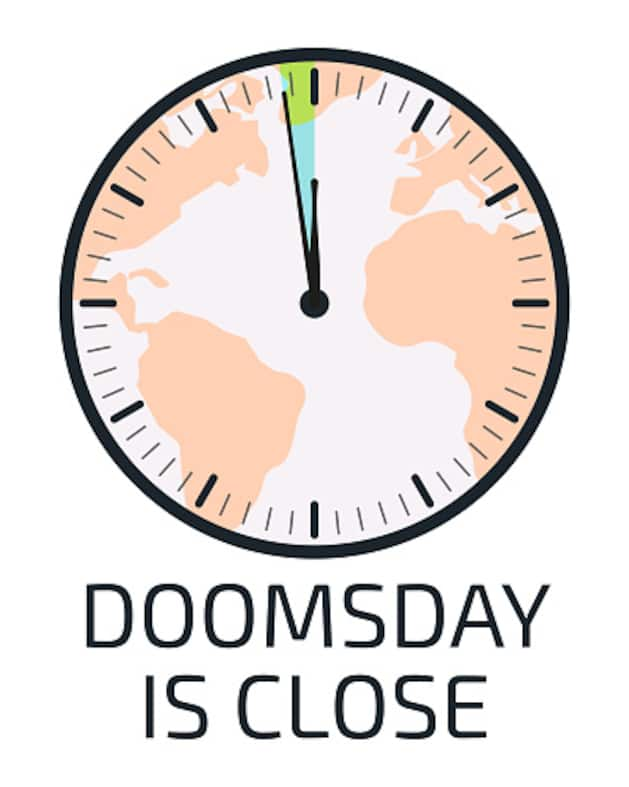The “Doomsday Clock” is now at 90 seconds to midnight – indicating a level of threat to humanity that has never been reached before. The pointer of the “doomsday clock” was advanced by another ten seconds.
The Bulletin of the Atomic Scientists cites the war in Ukraine and the escalation of the conflict with Russia, the climate crisis and biological hazards as the reason for their decision.
Since 1947, the doomsday clock has been a symbol of the threat to the world. It is intended to show how close humanity is to destroying itself through conflict, weapons and other man-made technologies. The committee of the “Bulletin of the Atomic Scientists” (BAS), founded by Albert Einstein, J. Robert Oppenheimer and other physicists, decides on the respective pointer position. For the past two years, the doomsday clock has stood at 100 seconds to twelve.
But now the Doomsday Clock is at a historically unprecedented level: It is only 90 seconds to midnight. Not even at the height of the Cold War did the committee, which includes ten Nobel Prize winners, rate the danger to humanity as high. “We live in a time of unprecedented threat, and the Doomsday Clock reflects that,” said Rachel Bronson, President of the Bulletin of the Atomic Scientists.
Panel member Ban Ki-moon, former UN Secretary-General, takes a similar view: “Three years ago, I was present at the last hand movement of the Doomsday Clock. Now its pointer is even closer to midnight. This shows how much more threatening the world situation has become in the wake of the corona pandemic, extreme weather and Russia’s war with Ukraine.”
The panel justifies its decision with an aggravation of the world situation in several areas. At the forefront is the Ukraine war: “Russia’s war with Ukraine has raised fundamental questions about how states interact and has eroded the norms of international interaction that form the basis for successful responses to global risks,” the statement said . “Russia’s thinly veiled threat to use nuclear weapons is a reminder to the world that escalation of conflict, whether accidental, intentional or mistaken, poses a terrible threat.”
Reading tips:
Germany delivers Leos – experts assess Kremlin threat: “War could escalate horizontally”
In addition, the Ukraine war has also drastically increased the risk of a catastrophic nuclear accident. Nuclear power plants in war zones such as Zaporizhia or the Chernobyl reactor are in acute danger of being damaged or not being adequately and safely monitored. So far, attempts by the International Atomic Energy Agency (IAEA) to place reactors on Ukrainian territory under special protection have largely failed.
But the danger of nuclear escalation is not unique to Ukraine, the committee said. China, India, Pakistan and the US continue to build up nuclear weapons and modernize their nuclear weapons instead of dismantling them. Since the end of the nuclear deal with the West, Iran has continued to enrich uranium and North Korea has once again intensified its nuclear monkey tests and missile program. In 2022, it launched a test rocket over Japanese territory.
The Bulletin of Atomic Scientists sees the climate crisis as the second major threat. Stagnant climate action, the energy crisis triggered by the Ukraine war and hardened fronts in negotiations have led to global greenhouse gas emissions hitting new record highs in 2021 and 2022. The consequences of climate change can also be felt almost everywhere: extreme weather and climate-related natural disasters are on the rise.
Reading tips:
Even before the year 2050 there is a risk of irreversible damage from global warming. This not only puts millions of people at risk, it also costs us billions of dollars, according to a new study.
“Tackling climate change requires trust in multilateral institutions and cooperation,” says IPCC lead author Sivan Kartha, one of the panel members. “The geopolitical rift created by the Russian invasion of Ukraine has damaged trust between states and weakened the will to cooperate globally.”
The scientists also see biological threats, for example from newly emerging pathogens and the increasing disinformation in the digital media, as potential dangers. Autocratic governments, anti-democratic groups and conspiracy theorists use the Internet as a platform to spread misinformation and undermine trust in reliable information and science.
“The doomsday clock is an alarm signal for all of humanity: We are on the brink of a precipice,” said committee member Mary Robinson, former chair of the United Nations High Commissioner for Human Rights. “We know what needs to be done, the science is clear but the political will is lacking. If we want to avert a catastrophe, this must finally change in 2023.”
This article was written by Nadja Podbregar
The original to this post “Doomsday Clock: Only 90 seconds left until the end of mankind” comes from scinexx.















